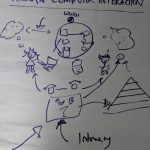[Part 1: The phenomena surrounding interactive computing systems ]
Lately, I have been doing an online six-week memoir course. I love a good online course and, this one is pretty good.
Each Thursday, a new module opens up in which I get to watch three videos starring the teacher who talks about a specific topic on memoir writing. After each video there is often a corresponding task and a resource which guides me, the student, to write my memoir.
My job is to absorb the lessons, read the resources and do the tasks. Then, I share one of the tasks, writing a maximum of 300 words, on an online forum where with my fellow students we give and receive feedback.
By the end of the course, I will have watched 18 videos, downloaded the 18 resources, and corresponding 16 tasks. The teacher has written a book on which the course is based, which I bought for £1 off Kindle, and which I have read as we have gone along which basically says keep going. So far, so fun.
The web site is okay, like these sites often are, it’s a bit oddly laid out, but, with a bit of trial and error, I have learnt how to navigate the design. The best decision they have made is that each week there is a new forum, so that I don’t have to try and find everything in one great big forum. However, this doesn’t work for everyone so they post their work from say, Week 1 in the forum for Week 4, so of course, there’s an admin who moves everything around to keep users’ interactions consistent within the design.
I like that there is a sidebar too which tells me about all my interactions, the comments on the things I’ve posted, and my responses to other people’s work or the responses my work has gotten. The rest of the time I dive into the forum so I can read people’s comments on other people’s work to see how they respond to some writing. This bit really interests me, as we can never anticipate for certain how someone will respond to something we say, write or design. People are endlessly fascinating and super creative.
The only aspects which distract me is that I have is trying to figure out how to manage the materials and the fact that they still need to hire someone to keep the design consistent, and potentially moderate too. Again, you never know if someone will do something unacceptable regardless that everyone has to read and agree to a specific behaviour before hand. Theoretically if you get the design right and employ the correct technology you wouldn’t need to do that. But, everybody does it, as in computer-supported cooperative work (CSCW) like this forum, it is cheaper and easier to get a human to do a computer’s job.
Naming conventions
We began okay, as on the very first week just after signed up, we got two resources, one contained a reading list and another had a ‘how-to’ guide to giving feedback to other writers, which were named according to the content each file contained, so they looked like this:

Looking at it, as a computer scientist, and as a writer, there is some naming inconsistency: hyphens in one and not in the other but, hey it’s still clear, it works, so far so good.
Alas, after that, we got into the weekly releases and the naming convention, that you can see from the image at the top of the file with a close up snippet here to show you, was not so good:

Theoretically, this naming convention is accurate and reflects the structure of the course. Each file contains a task or resource from ‘Week 1 to 6’ on the ‘Writing a memoir course’ so I can find each resource and task once again should I want to.
However, it will not be easy to find anything because that is not how humans think. Even when downloading them, I couldn’t remember which ones I had already downloaded as it was hard to see as the filenames are so long because they all begin with Writing-a-memoir. So, I couldn’t see if I’d already downloaded Writing-a-memoir-Week-1-Resource-1.pdf, before I downloaded it again.
It’s not terrible but it’s not helpful because when I look back at the course materials, I won’t be thinking: Ah yes, I’d like to look up Week 1, Resource 1, as I won’t remember what is in it because it has no meaning for me. Numbers have no meaning, unless I am doing a maths problem. Instead, I will think: Ah yes, I’d like to look again at the different forms of memoir, was that a task or a resource? What week was that then? Then I will have to spend time going through opening each file from every week.
And, this is something I see all the time, in coding and in file naming and everywhere. Like, I’ve said before, I would never say to my husband: I am taking child 1 to the dentist, or bike 1 to the repair shop. So why do we do this when we start organising data or code in files and directories?
I think we do it as we are talking to a computer in a vacuum forgetting all about people who will need this information at the end and not thinking at all about what will happen to the files once they stop being on the server and someone has to use them.
When I download the files, I will put them all in the same directory so I won’t need the beginning Writing a memoir part of the file name, because that will be the name of the directory. So, the file I am looking for in the instance of Wk1 Tk1 should be named something meaningful such as Different-forms-of-memoir.pdf. I could even put in Wk1R1 if the chronology of the files is important to me, but I would put that at the end of the filename, so that the most important information comes first: Different-forms-of-memoir-R1-Wk1.pdf or even Different-forms-of-memoir-Resource1-Week1.pdf. It’s not a massive change, but it is a good one, which improves the user experience in a huge way.
Because it is not currently like that, anytime I look at these files I feel frustrated and think: I should rename all these. What I have done is combine them all into one document so that I can flick through and find the page I want. But, that comes with another set of problems like: Where’s the table of contents? All the pages look the same and have meaningless titles until we get to the second title which I cannot read until I open up the file.

How much nicer would it have been if I could have just had meaningful file names so when I think: I want to look at the task/resource about writing dialogue, I can just open my Writing a memoir directory and find the file called writing-dialogue.pdf, and if it is named writing-dialogue-wk4-t3.pdf, even better as I can think to myself: Wow I thought we did that much earlier on, for we go on a journey when we go on a course and our experience with time is fluid.
Directories too
The same applies if you create a directory, even if you do not think you will share it with someone, but especially if you do, it’s good to do it in a way to future proof it.
Here are some simple rules about how to create a file structure that helps either you or someone else go back later and immediately understand what is in each file and each file directory without having to open up all the files and figure out what is going on:
- Make the filename meaningful like we have discussed above: writing-dialogue-wk4-t3.pdf not Writing a memoir wk4 t3.pdf and be consistent.
- If the file is by itself, you do not need a whole directory for it, do not do nested directories so that people have to open each directory within a directory to find only one file. This is infuriating and if you are accessing the file structure in a GUI say on a drive, it can be difficult to backup, because some setups such as Google drives will not recursively copy directories so you have to copy each file at a time.
- If you are putting files in a directory make the directory name meaningful, so that no one has to go into the directory and figure out what the name means. In this case Writing-a-memoir-May2025. Ideally in each directory, there would be a readme.txt with a couple of lines describing what the directory contains, when it was last updated and by whom. This is a nerdy computer thing, but remarkably useful.
- Only similar files should be in a directory, so as in our example above, they don’t need all to begin with Writing a memoir… the directory should be called that so that the filenames can begin with a description of what is in the file.
- If you are replacing a file, for example, one full of passwords (I won’t even get into why this is a bad idea to begin with), delete the old file. Do not hold onto old information which you will never use again. Get rid of it otherwise, people won’t know which file to look in, especially if you haven’t used a good naming convention.
- Never name a file or directory thinking you will come back to it and remember what you are talking about such as old files from the x project. This will not happen. Name the files as if someone brand new is coming in and needs to know exactly what they are about, when they were created and why.
- If you want to use the date as part of a filename, make sure it is consistent and clear. I use the name of the month so that no one gets confused by the order of the date i.e., American dates versus British: 25May2025 rather than 05/25/25 or 25/5/25 which is clear in this example but not in 06/05/25. Is that 5th June 2025 of 6th May 2025? The downside of using month names is that when we get into January or September the file names can become quite long and then also they will be listed alphabetically and not chronologically which might be a problem. Make sure there is a readme.txt file which explains any naming convention if you are not sure that it is clear from the file name. E.g.,
**readme.txt, created 25-05-2025, by Ruth SF
The date format we are using for the filenames in this directory is as follows: dd-mm-yyyy
In this directory are all the handouts from the six week memoir course Writing a memoir.
Better still make it clear.
Once we read through this sort of advice, it may seem obvious, but it isn’t. Effective communication isn’t easy but it is necessary. We have to ask ourselves before we store anything.
- Why are we keeping this?
- Who will read it in the future?
- Who is it for?
When we can answer these questions we can think about how to store things appropriately.
The same goes for sending out messages: emails/texts/etc. People are overwhelmed on a daily basis, so if you are sending a message, make sure that it has meaning and conveys relevant information in an appropriate manner.
Meaningless messages
Everyday now, I get a lot of meaningless email automatically generated by systems which contain useless information. For example, the other week I had to book an appointment for my cat, Tigger. I was worried about his teeth, so I went to the online system and checked the options. I had a choice between general check-up or teeth. I went with teeth, and booked the appointment. Then I reflected on it, and decided I wanted not just his teeth to be checked so I went back to change it.
However, the system was brittle so I could only cancel the appointment not reschedule, which I did. Then I booked a general check-up. When I got there, I mentioned his teeth and asked the vet what the best way of managing this situation was. The vet said that they didn’t understand why the system was implemented that way because all cats get their teeth checked during a general check-up.
This is a common mistake in designing a system. It doesn’t in anyway reflect the real world, leaving all the stakeholders (in this case, me, my cat and the vet) confused and not knowing which option to choose.
Turns out Tigger’s teeth are fine. It seems that he didn’t like his kibble anymore so I have swapped over to one he prefers and he is happily chomping on down once more. Honestly. Job done. Or was it? A day or two later I got another message saying:

The system was chasing me to make another appointment because it didn’t have the capacity to cross-check my new appointments, it just assumed I had cancelled my appointment and not rescheduled another one. I haven’t a means of telling it, so instead it sent me several pointless email reminders, until, it stopped as randomly as it started.
Last winter, I got a reminder to book my daughter’s flu jab at school which I did. The morning that the jab was scheduled I was sent a message and an email reminder. I didn’t remind my daughter, as I thought, no need to give her something unpleasant to look forward to, she can find out just before she gets it.
That afternoon I got this message:

I found this to be such a frustrating message. I know I consented, it was a very long and boring form. Why didn’t she get the jab? Did she miss it? Could they not find her? Why did they not tell me the most important bit of information? Why not?
When my daughter came home, and I asked her why it didn’t happen, she didn’t know. Though, she had seen people leaving the room for the flu nasal spray so she eventually went and asked, only to be told they weren’t doing injections that day.
It would have been easy enough to generate a reason for her not receiving a jab whilst sending me automated message. It could have been a drop down box with a choice of reasons as these systems don’t work themselves, there is an admin person. Instead they went with if you wish to know more phone here/email here/click here, all which led nowhere.
The next day the school wrote an apology to the parents explaining what had happened – something along the line of bad organisation by the vaccination people though the school of course was far to polite and lovely to say that – and then later on another letter with a new date, and then more messages from the vaccination organisation to say that my daughter was getting a jab that day, which I didn’t believe until she came home and said she’d had it.
Below, is one of many emails I receive everyday, I didn’t know what it was on about at the time. I don’t remember now and why does anyone send out generic meaningless email?

But I have worked with people (actually I’ve never seen a woman do this), who don’t read their emails. They will fire off many email before they have read any of my emails which I have written in response to their emails, so that their emails are just random stream of consciousness, completely unrelated. Then they read my emails and then respond to each one individually, so each interactions with them takes about eight email messages which is just mind-boggling especially when it is about something really simple like organising a meeting. I do not know how these people are still employed.
All communication and all software systems begin and end with people but when people and systems are generating endless, endless messages because they cannot seem to remember that this is people to people, life becomes infinitely more tiring.
Interaction goes both ways
I’ve said over the years that people want to be seen, heard and understood to which I need to add, they also want to see, hear and understand.
We shouldn’t all have to turn detective because someone forgot when they set up an automated system that at the end of the line, there are real people who need answers and real information. Not half baked, badly thought out messages.
And as a person often on the receiving end, I should have full control if I want to receive these messages at all, otherwise you are just spamming me. I am talking to you MyChart!
Just because we can message people all day long, it doesn’t mean we should. We need our systems to be designed with some thought which begins with asking the question: When someone reads this filename/message/directory/download will they understand? If there’s a slight chance that they won’t, then let’s all take a minute to design it better so that they do.
Design is communication and so make sure it communicates with clarity.






